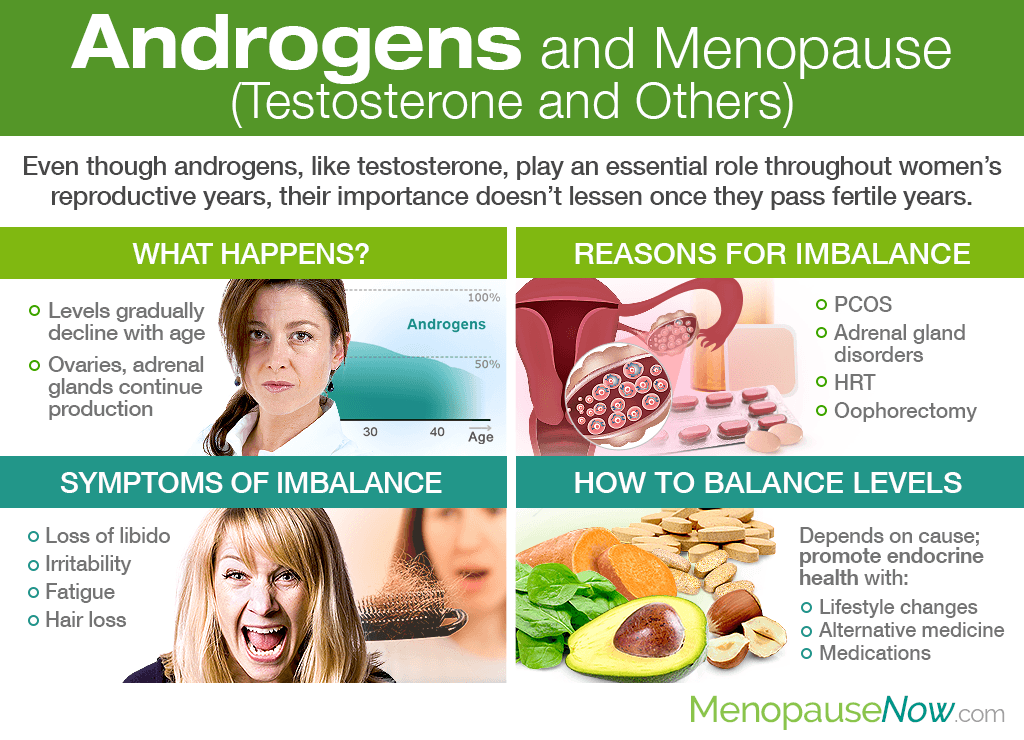Androgens, such as testosterone, play an instrumental role in women's hormonal health throughout their lives. When their levels become imbalanced, a variety of symptoms can be provoked. Continue reading to learn more about androgens and menopause, including what happens to their production, what this means for women, and how to effectively treat menopause androgen levels.
What Happens to Androgens During Menopause?
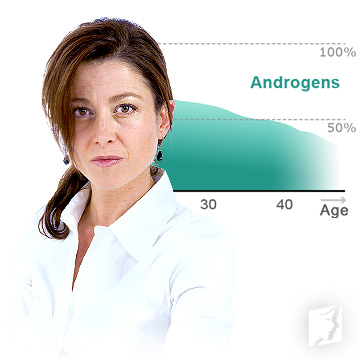
Mainly produced by the adrenal glands and the ovaries, the major androgens present in women's bodies are testosterone, androstenedione, and dehydroepiandrosterone (DHEA).
Throughout women's reproductive lives, androgens' levels steadily decline after 20 years of age. Once a woman reaches 40, which is around the time she may enter perimenopause, testosterone levels are about 50 percent of what they were.
However, this is not necessarily attributable to cessation of reproductive function because unlike estrogen and progesterone during menopause, the ovaries continue to produce testosterone during and past menopause. Testosterone production from adrenal glands declines slightly past menopause, but it also continues.
Reasons for an Androgen Imbalance
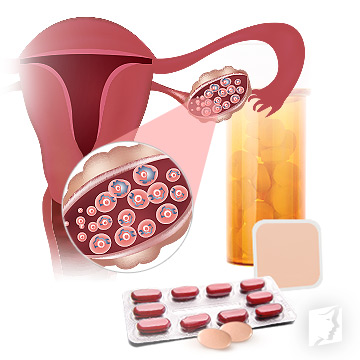
There are several causes of an imbalance of menopause androgen levels, including, but not limited to:
Polycystic ovary syndrome
Polycystic ovary syndrome (PCOS) is an endocrine system disorder that can cause the ovaries to make extra amounts of testosterone. Though most common in premenopausal women, the condition can continue into menopausal and postmenopausal years.
Adrenal gland disorders
Adrenal gland disorders - such as the genetic disorder congenital adrenal hyperplasia that causes hyperandrogenism or adrenal insufficiency that leads to hypoandrogenism - can cause imbalanced menopause androgen levels in women.
Hormone replacement therapy
Many doctors may prescribe hormone replacement therapy (HRT) for women suffering from any type of hormonal imbalance. However, improper dosing may cause excess levels of androgens and, subsequently, imbalance symptoms.
Oophorectomy
Oophorectomy is the surgical removal of the ovaries. It is oftentimes performed alongside a hysterectomy, the surgical removal of the uterus. Removal of the ovaries before natural menopause is known as surgical menopause, and afterwards, menopause androgen levels will be imbalanced as the ovaries were main producers of the hormones.
Symptoms of an Androgen Imbalance
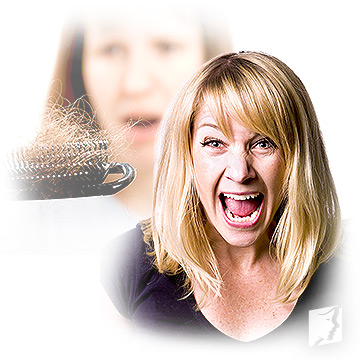
An imbalance of menopause androgen levels manifest in the following ways:
- Hot flashes
- Night sweats
- Loss of libido
- Mood swings
- Irritability
- Depression
- Decreased energy levels
- Lack of well-being
- Loss of muscle mass
- Fatigue
- Hair loss
- And more
It is worth noting that while an androgen balance can provoke aforementioned symptoms, many are also characteristic of an estrogen or progesterone imbalance.
Risks of a Long-Term Androgen Imbalance
Menopausal women whose androgen levels are unhealthily low for extended periods of time are at a higher risk of developing more grave health problems, such as:
- Bone mineral density loss
- Height loss
- Bone fractures
- Arthritis
- Osteoporosis
How to Balance Menopause Androgen Levels
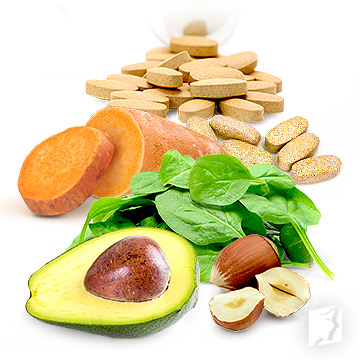
Women's first line of action should be to confirm with their doctor if they are suffering from androgen deficiency or androgen dominance as both imbalances have their respective treatments.
While many menopausal women are strongly encouraged to pursue HRT to combat symptoms, due to the potential severe side effects, balancing menopause androgen levels is recommended to be approached differently.
Menopause symptom treatments focus on the implementation of lifestyle changes alongside the use of alternative medicine to help women find hormonal balance the natural way.
No matter the type of imbalance, lifestyle changes may consist of the following measures to promote endocrine health:
Wholesome diet. Constructing a balanced diet of healthy fats, complex carbs, and lean protein consumed primarily from plant-based options is a good starting point for women looking to optimize their eating habits for hormonal health. Legumes, nuts, seeds, avocadoes, sweet potatoes, and fresh fruits and vegetables, like spinach and kale, are viable choices.
Regular exercise. Regular exercise performed 30 minutes a day, five days a week not only promotes a hormonally stable body, but also boosts mood, helps resolve any newly onset menopause sleeping disorders, and combats weight gain. For those looking to specifically increase menopause androgen levels, incorporate moderate resistance and strength training into your workout routine.
Healthy habits. All women, no matter their hormonal situation, should strive to quit harmful addictions (alcohol, excess caffeine, tobacco, etc.); decrease stress levels through meditation, yoga, tai chi, or deep breathing exercises; rest at least seven to eight hours of uninterrupted sleep each night; and improve gastrointestinal health by consuming adequate amounts of fiber and probiotics.
For improved results, women should consider the use of alternative medicine, specifically hormone-regulating supplements.
Hormone-regulating supplements, like Macafem, nourish and encourage the endocrine glands to produce more of their own hormones, thus allaying any androgen imbalance and accompanying symptoms during menopause. Moreover, because they do not introduce external hormones into the body, they are safe for long-term use.
In some cases, medications will be added to the aforementioned measures to address an androgen balance better.
Nevertheless, you should always check with your doctor to craft the best androgen menopause treatment plan for your specific case.
Rest assured that with a little initiative, achieving a hormonally balanced, symptom-free life is within reach.
Sources
- Australasian Menopause Society. (2017). Surgical Menopause. Retrieved July 11, 2019, from https://www.menopause.org.au/hp/information-sheets/756-surgical-menopause
- Center for Young Women's Health. (2018). PCOS (Polycystic Ovary Syndrome): General Information. Retrieved July 10, 2019, from https://youngwomenshealth.org/2014/02/25/polycystic-ovary-syndrome/
- Healthy Women. (2009). Androgen. Retrieved July 9, 2019, from https://www.healthywomen.org/condition/androgen
- Lasley, B.L. et al. (2011). Adrenal Androgens and the Menopausal Transition. Obstetrics and Gynecology Clinics of North America, 38(3), 467-475. doi: 10.1016/j.ogc.2011.06.001
- Morley, J.E. & Perry, H.M. (2003). Androgens and Women at the Menopause and Beyond. The Journals of Gerontology: Series A, 58(5), M409-M416. doi: 10.1093/gerona/58.5.M409
- Shulman, L.P. (2009). Androgens and menopause. Minerva Ginecologica, 61(6), 491-497. Retrieved July 9, 2019, from https://www.ncbi.nlm.nih.gov/pubmed/19942837

